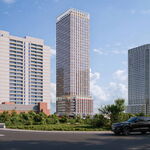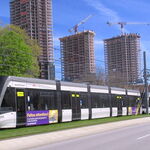Northern Light
Superstar
I think its worth saying, irrespective of the merits of different structures, that a pure fare by distance model, and/or one that applies a premium to subway rides is a political non-starter at this time, absent substantial new subsidies.
I think Metrolinx is being politically obtuse if they are serious about this option.
It will be vetoed faster than road tolls.
That's not a comment on merit, but on whether provincial politicians value their re-election.
****
To me, given the political realities, as well as the fiscal ones, I would argue for a modified status quo.
Phase in charging for parking for GO, but off-set this with lower GO fares, with a disproportionate reduction for short-haul trips.
In order not to produce rebellion among the suburban commuter class, the price reduction would have to precede any slowly phased in parking charge, and this would
be funded by a modest provincial subsidy to GO that would be phased back out (or diverted to higher service levels.
Second, I would suggest a zone system; but with the zones being the existing major transit systems with the exception of Brampton/Miss, which I would combine as one zone.
Third, harmonize the existing local system fares, roughly at the average of the current fare structures (no radical change).
Fourth, make a GO co-fare universal, partially cover the cost by raising existing co-fares from around .75c to $1.25; the rest has to be covered by new subsidy.
Finally, deal with short-haul trips that cross zone borders by one of three options.
a) A model that makes all cross-zone trips a co-fare (ie. add $1.25 each time you cross zone)
b) A model that identifies a select number of routes where no added fare should be charged that would meet the needs of the majority of cross-border trips (ie DRT to UTSC, or Miss/Brampton to Humber College North etc. etc.
c) A model that caps your total monthly expenditure regardless of what trips you take. (like a Metropass, but covering a wider area, at a higher price point)
I think Metrolinx is being politically obtuse if they are serious about this option.
It will be vetoed faster than road tolls.
That's not a comment on merit, but on whether provincial politicians value their re-election.
****
To me, given the political realities, as well as the fiscal ones, I would argue for a modified status quo.
Phase in charging for parking for GO, but off-set this with lower GO fares, with a disproportionate reduction for short-haul trips.
In order not to produce rebellion among the suburban commuter class, the price reduction would have to precede any slowly phased in parking charge, and this would
be funded by a modest provincial subsidy to GO that would be phased back out (or diverted to higher service levels.
Second, I would suggest a zone system; but with the zones being the existing major transit systems with the exception of Brampton/Miss, which I would combine as one zone.
Third, harmonize the existing local system fares, roughly at the average of the current fare structures (no radical change).
Fourth, make a GO co-fare universal, partially cover the cost by raising existing co-fares from around .75c to $1.25; the rest has to be covered by new subsidy.
Finally, deal with short-haul trips that cross zone borders by one of three options.
a) A model that makes all cross-zone trips a co-fare (ie. add $1.25 each time you cross zone)
b) A model that identifies a select number of routes where no added fare should be charged that would meet the needs of the majority of cross-border trips (ie DRT to UTSC, or Miss/Brampton to Humber College North etc. etc.
c) A model that caps your total monthly expenditure regardless of what trips you take. (like a Metropass, but covering a wider area, at a higher price point)





